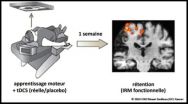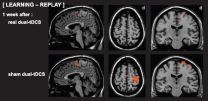Stroke: Promising results of an important study published in the scientific journal Brain
2014-12-09
(Press-News.org) Neuro-rehabilitation (physical therapy, occupational therapy, etc.) helps hemaparetic stroke patients confronted with loss of motor skills on one side of their body, to recover some of their motor functions after a cerebrovascular accident. One of the most promising tracks in neuro-rehabilitation consists in amplifying the motor learning ability after a stroke, in other words how to learn (again) how to make movements with the parts of the human body impacted after a stroke.
Pilot studies have shown at this matter that tDCS (transcranial direct current stimulation) - a non-invasive and painless cerebral stimulation method - allowed to modulate the cerebral activity and to increase the motor performances of patients who have been victim of stroke. This method consists of applying low voltage electric currents on the patient's head by means of electrodes during short periods of time. In 2012, a first study conducted by the teams of Professors Yves Vandermeeren and Patrice Laloux allowed to demonstrate that tDCS amplified the motor learning and the long-term motor memory of the patient after a stroke. This study was awarded with the Fernand Depelchin Prize of the Université catholique de Louvain (UCL) and allowed the CHU Neurology Team to continue its research, in particular via the use of functional Magnetic Resonance Imaging (fMRI) of the brain.
Nineteen hemiparetic stroke patients (with a motor deficit in the upper limb) participated to this new clinical trial. In order to avoid study bias, the stimulations were performed in a double-blind, randomised fashion. Each patient received a real stimulation as well as a placebo-stimulation during two separate sessions. Because the tDCS was as good as completely imperceptible, it became impossible for patients to determine if they received a true or a placebo-stimulation.
During the first stimulation session (real or placebo), the patients learned how to perform a task with a paralysed hand, combining speed and accuracy. One week later, they performed the learned task while the functional MRI scanner recorded their cerebral activity. After one week, this experience was completely done over again with the other stimulation (placebo or real).
As in the previous study, the non-invasive cerebral stimulation amplified the motor learning capacity with the paralyzed hand and the long-term memory retention in a spectacular way for patients with a chronic stroke.
Thanks to functional MRI, this second study demonstrates that the combination of motor learning and non-invasive cerebral stimulation improves the efficiency of the cerebral activity. Indeed, one week after the placebo stimulation, the cerebral activations measured via the functional MRI was very diffuse. Large cerebral zones were somehow « recruited » although motor performance was low (poor retention). On the other hand, one week after real stimulation, the cerebral activation was focussed on the essential motor zones, almost identical to a person without stroke-impact although the motor performance was significantly better (enhanced task retention). In other words, the combination of motor learning and tDCS reinforced the essential motor zones and this specific network was reactivated one week after the real intervention.
For thousands of stroke victims, this study opens considerable perspectives in the domain of neuro-rehabilitation. A better understanding of the cerebral functioning after a stroke and how non-invasive cerebral stimulation works will help researchers to develop the neuro-rehabilitation of the future. The results of this study will be implemented within the consortium Louvain Bionics, inaugurated on November 12 of this year at UCL.
INFORMATION:
[Attachments] See images for this press release:


ELSE PRESS RELEASES FROM THIS DATE:
2014-12-09
Nidelric pugio fossil dates to half a billion years ago and teaches us about the diversity of life in Earth's ancient seas
In life the animal was a 'balloon' shape and was covered in spines, but the squashed fossil resembles a bird's nest
Named in honour of Professor Richard Aldridge from the University of Leicester
A rare 520 million year old fossil shaped like a 'squashed bird's nest' that will help to shed new light on life within Earth's ancient seas has been discovered in China by an international research team - and will honour the memory of a University of ...
2014-12-09
Montreal, Canada, November x, 2014 - Angiochem, a clinical stage biotechnology company creating and developing drugs that cross the blood-brain barrier, today announced the publication in Molecular Cancer Therapeutics demonstrating that ANG4043, a peptide-monoclonal antibody (mAb) conjugate, entered the brain at therapeutic concentrations, resulting in significantly prolonged survival in mice. The antibody is directed against HER2, which is the protein targeted by Herceptin®. Because the mAb is conjugated to Angiopep-2, it is recognized by the LRP1 receptor and takes ...
2014-12-09
Phoenix, AZ (December 9th, 2014) - Healthy, elderly research participants who report being more sleepy and less rested have higher levels of amyloid deposition in regions of the brain that are affected in Alzheimer's disease, according to a report presented today at the American College of Neuropsychopharmacology annual meeting in Phoenix (Arizona). If sleep disturbance is a cause of amyloid accumulation, it may be an early target for intervention to prevent the progression of cognitive deficits in late life.
Numerous studies have shown the importance of sleep and the ...
2014-12-09
Phoenix, AZ (December 9th, 2014) - Abnormalities in the prefrontal cortex and related brain areas are observed in adolescents who have attempted suicide, according to a report today at the American College of Neuropsychopharmacology annual meeting in Phoenix Arizona. The study suggests that deficits in frontal systems may be associated with risk for suicide attempts in youths with mood disorders.
Most suicide attempts occur in the context of mood disorders, including bipolar disorder and major depressive disorder. Bipolar disorder has a prevalence of 3-4% in the U.S. population, ...
2014-12-09
A multicenter phase 1 trial of the immune checkpoint blocker ipilimumab found clinical benefit in nearly half of blood cancer patients who had relapsed following allogeneic stem cell transplantation, according to investigators from Dana-Farber Cancer Institute, who developed and lead the study.
The study reported at the American Society of Hematology annual meeting is the first in which ipilimumab was given in multiple doses over an extended time period, the researchers said.
At a median follow-up time of six months, "We have seen less toxicity than expected and a strong ...
2014-12-09
A study that investigated the potential of the compound PRM-151 (PRM) for reducing progressive bone marrow fibrosis (scarring) in patients with advanced myelofibrosis has shown initial positive results. Myelofibrosis is a life-threatening bone marrow cancer.
The study, led by Srdan Verstovsek, M.D., Ph.D., professor of leukemia at The University of Texas MD Anderson Cancer Center, showed the compound was well tolerated in observing 27 patients. Verstovsek's research results were presented today at the 56th Annual Meeting of the American Society of Hematology (ASH) annual ...
2014-12-09
Aiming to empower planners and policy-makers to achieve better health for billions of people living in fast-growing urban areas, world health, environmental, behavioural and social science experts today launched a major new interdisciplinary scientific collaboration.
Programme goals:
Empowering planners and policy-makers with better science to create healthy urban environments and improve wellbeing;
Identify and manage unintended health consequences of urban policy;
Understand connections between cities and planetary change
Leading the consortium of science ...
2014-12-09
Opposing views on the potential impact of electronic cigarettes on public health are published in the open access journal BMC Medicine. The commentaries, by two experts, differ in their views on the topic but are united in their call for a rational discussion based on evidence.
The authors examine the WHO's recommendations earlier this year. One recommendation was that smokers should not use e-cigarettes and has now been withdrawn, and the other is that policymakers should implement their strict regulation, which is still in force.
In one of the commentaries, Peter ...
2014-12-09
Sophia Antipolis, 09 December 2014: Heart disease patients have been advised to avoid being outside during rush hour traffic in a paper published today in European Heart Journal.1 The position paper on air pollution and cardiovascular disease was written by experts from the European Society of Cardiology and also recommends decreasing the use of fossil fuels.
Professor Robert F. Storey, corresponding author of the paper, said: "More than 3 million deaths worldwide are caused by air pollution each year. Air pollution ranks ninth among the modifiable disease risk factors, ...
2014-12-09
There is no need to spray insecticide on walls for malaria control when people sleep under treated bed nets, according to new research.
Use of insecticide sprayed on internal walls, when combined with insecticide-treated bed nets in homes, does not protect children from malaria any more effectively than using just insecticide-treated bed nets, the research led by Durham University and the Medical Research Council's Unit in The Gambia found.
The researchers said this was important as insecticide-treated nets and insecticide sprayed on walls are commonly used for controlling ...
LAST 30 PRESS RELEASES:
[Press-News.org] Stroke: Promising results of an important study published in the scientific journal Brain



